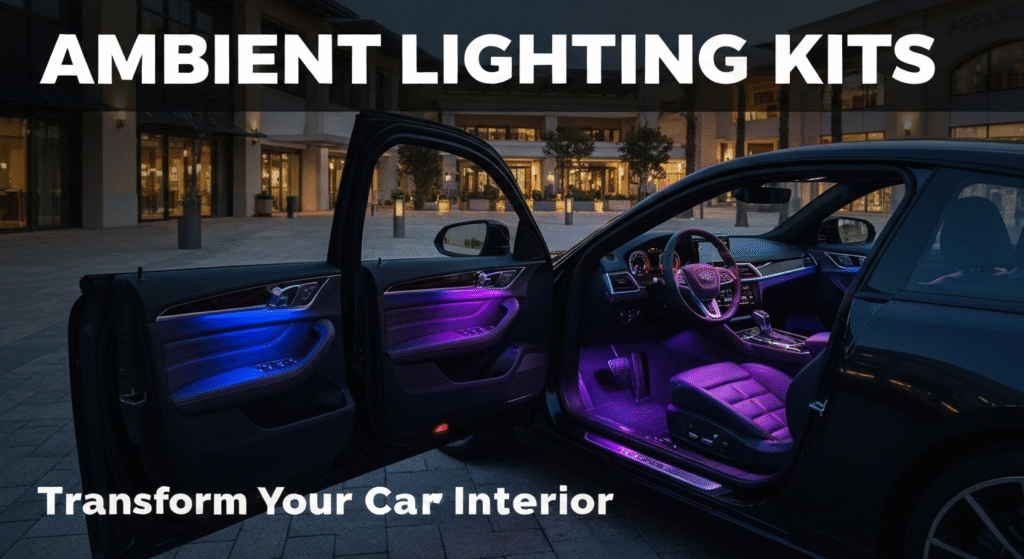Your car’s interior doesn’t have to feel like a basic transportation box. With the right ambient lighting kit, you can create the same premium atmosphere found in high-end luxury vehicles. As someone who has spent five years working with automotive customization and interior enhancement solutions, I’ve helped countless car owners discover how simple lighting modifications can completely transform their driving experience.
My name is Sharmin, and I’ve been a professional automotive interior specialist for over half a decade. During this time, I’ve installed hundreds of ambient lighting systems across various vehicle types, from compact cars to luxury SUVs. What started as a passion project in my garage has evolved into extensive expertise in automotive lighting solutions, electrical systems, and interior design principles.
Ambient lighting kits represent one of the most cost-effective ways to upgrade your vehicle’s interior. These systems use LED strips, fiber optics, or individual LED modules to create soft, indirect lighting throughout your car’s cabin. The technology has advanced dramatically over the past few years, making professional-grade lighting accessible to everyday car owners.
What Ambient Lighting Kits Actually Do
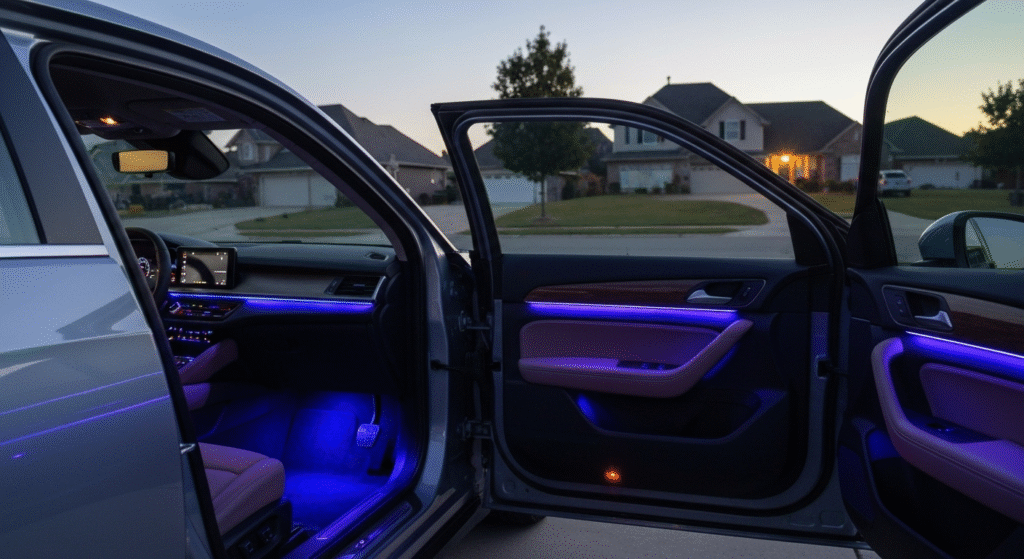
Ambient lighting serves multiple purposes beyond simple aesthetics. The primary function involves creating indirect illumination that enhances visibility without causing glare or distraction. This type of lighting fills spaces with gentle, even light that reduces harsh shadows and creates a more comfortable environment.
Modern ambient lighting systems typically include multiple color options, brightness controls, and various lighting modes. The most sophisticated kits sync with your music, respond to driving conditions, or follow preset patterns. These features allow you to customize the lighting experience based on your mood, time of day, or driving situation.
The psychological impact of ambient lighting shouldn’t be underestimated. Proper lighting reduces eye strain during night driving, creates a more relaxing atmosphere during long trips, and can even help reduce driving anxiety. Many users report feeling more confident and comfortable in their vehicles after installing these systems.
Types of Ambient Lighting Systems
LED Strip Lighting LED strips represent the most popular choice for ambient lighting installations. These flexible strips contain multiple small LEDs that produce consistent, even light distribution. They work well for door panels, dashboard areas, footwells, and center console applications.
Fiber Optic Systems Fiber optic ambient lighting creates unique lighting effects through thin, flexible cables that transmit light from a central source. This technology excels at creating starlight effects on headliners or subtle accent lighting in hard-to-reach areas.
Individual LED Modules Some systems use individual LED units placed strategically throughout the interior. These modules offer precise control over specific lighting zones and work well for accent lighting applications.
Lighting TypeBest Use CaseInstallation DifficultyCost RangeLED StripsDoor panels, footwellsEasy to Moderate$50-$200Fiber OpticHeadliner, accent areasModerate to Hard$150-$500LED ModulesSpecific zonesEasy$30-$150
Choosing the Right Ambient Lighting Kit
Selecting the appropriate ambient lighting system depends on several factors. Your vehicle type, budget, installation skills, and desired lighting effects all influence the best choice for your situation.
Vehicle Compatibility Not all lighting kits work with every vehicle type. Older cars may require additional wiring modifications, while newer vehicles often have existing electrical systems that support aftermarket lighting. Check your car’s electrical capacity and available connection points before purchasing any kit.
Power Requirements Most ambient lighting systems draw minimal power, typically between 10-50 watts total. However, you should verify that your vehicle’s electrical system can handle the additional load without affecting other components. Modern cars usually handle these requirements without issues.
Color Options and Control Basic kits offer single-color lighting, while advanced systems provide RGB color mixing with thousands of possible combinations. Consider whether you want static lighting, color-changing effects, or music synchronization features. More complex systems require additional control modules and wiring.
Installation Considerations
The installation process varies significantly based on the chosen system and your vehicle’s design. Some kits require basic wire connections and adhesive mounting, while others involve removing interior panels and running wiring harnesses throughout the vehicle.
DIY Installation Factors:
- Basic electrical knowledge requirements
- Tool availability and skill level
- Time commitment (2-8 hours typically)
- Warranty implications
- Reversibility if needed
Professional Installation Benefits:
- Guaranteed proper wiring connections
- Clean, hidden wire routing
- Warranty protection
- Troubleshooting expertise
- Time savings
During my years installing these systems, I’ve learned that rushing the installation process often leads to problems later. Taking time to plan wire routing, test connections, and secure all components properly prevents issues down the road.
Installation Process and Best Practices
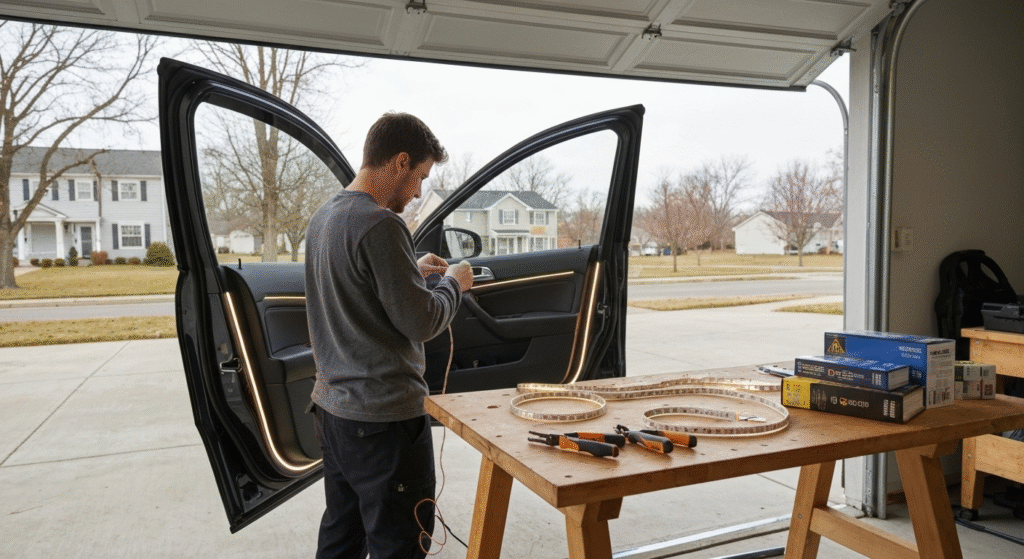
Installing ambient lighting requires careful planning and attention to detail. The process typically involves mapping out lighting zones, running power connections, mounting LED strips or modules, and testing the entire system.
Pre-Installation Planning Start by identifying the areas where you want lighting effects. Common locations include door panels, dashboard edges, footwells, center console areas, and seat tracks. Draw a simple diagram showing wire routing paths and power connection points.
Power Source Selection Most installations connect to the vehicle’s accessory power circuit, which turns lights on and off with the ignition. Alternative connection points include constant power sources for always-on operation or switched circuits that activate with door opening or other triggers.
Wire Routing Techniques Professional installations hide all wiring within existing vehicle panels and trim pieces. This approach requires removing interior components but results in a clean, factory-like appearance. Surface-mounted wiring looks unprofessional and risks damage from normal vehicle use.
Common Installation Challenges
Panel Removal Difficulties Some vehicles have complex interior panel designs that make wire routing challenging. Research your specific vehicle’s panel removal procedures before starting the installation. Online forums and service manuals provide valuable guidance for specific car models.
Limited Power Access Points Older vehicles may have fewer convenient power connection options. In these cases, you might need to add fuse taps or run longer wire runs to reach appropriate power sources. Always use proper fusing to protect both the lighting system and vehicle electrical components.
Space Constraints Compact cars often have limited space for hiding control modules and wire routing. Plan component placement carefully to avoid interference with existing vehicle systems or passenger comfort.
Installation ChallengeSolutionTime ImpactSkill LevelPanel RemovalResearch procedures+2-3 hoursIntermediatePower AccessAdd fuse taps+1-2 hoursBasicSpace ConstraintsCompact components+1 hourBasicWire RoutingPlan paths carefully+2-4 hoursIntermediate
Popular Ambient Lighting Kit Options
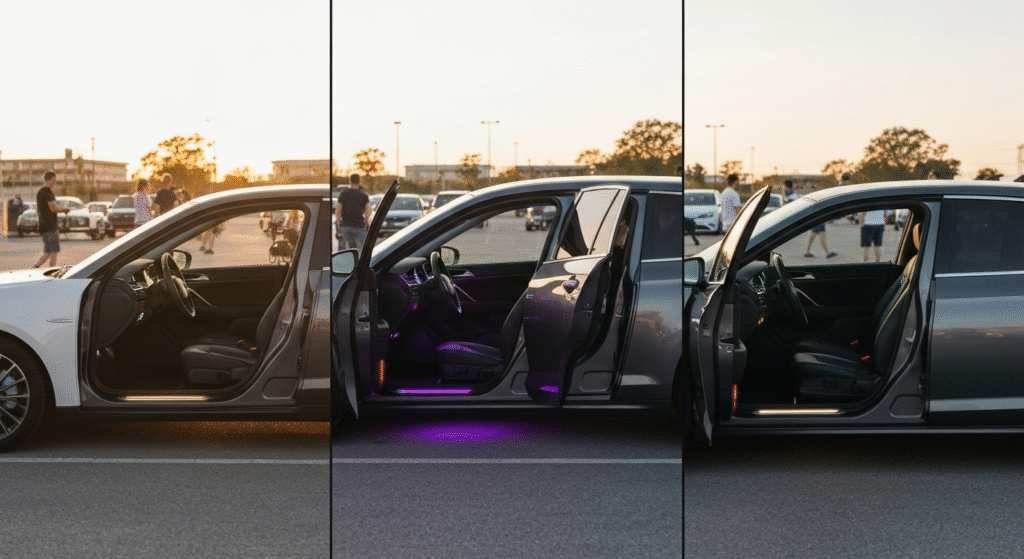
The market offers numerous ambient lighting solutions ranging from basic single-color strips to sophisticated multi-zone systems with smartphone app control. Understanding the available options helps you make informed decisions based on your needs and budget.
Budget-Friendly Options ($50-$150) Entry-level kits typically include basic LED strips, power connections, and simple color controls. These systems work well for first-time installations and provide significant visual improvement at minimal cost. Most budget kits offer 8-12 preset colors with manual selection controls.
Mid-Range Systems ($150-$400) Mid-tier options add features like smartphone app control, music synchronization, and multiple lighting zones. These systems often include more sophisticated LED strips with better color accuracy and brightness control. Installation complexity increases with additional control modules and wiring requirements.
Premium Solutions ($400+) High-end ambient lighting systems rival factory luxury vehicle installations. They offer precise color mixing, multiple lighting zones, advanced control options, and professional-grade components. Some premium systems integrate with existing vehicle electronics for seamless operation.
Brand Recommendations and Performance
Based on my installation experience, certain brands consistently deliver reliable performance and quality components. Govee, Philips, and EL-Wire systems represent solid choices across different price ranges. Each brand offers unique advantages in terms of color accuracy, durability, and ease of installation.
Govee Systems Govee produces popular RGB LED kits with smartphone app control and music synchronization features. Their systems offer good value for money and relatively straightforward installation processes. The mobile app provides intuitive control over colors, brightness, and lighting effects.
Philips Lighting Philips brings professional lighting expertise to automotive ambient lighting. Their systems focus on color accuracy, build quality, and longevity. Installation tends to be more complex, but the results justify the additional effort for users seeking premium performance.
EL-Wire Solutions Electroluminescent wire creates unique lighting effects different from traditional LED systems. EL-wire produces continuous, even illumination along its entire length and works well for accent lighting applications. These systems typically cost less than LED alternatives but offer fewer color options.
Advanced Features and Customization
Modern ambient lighting systems offer sophisticated features that extend far beyond simple colored lighting. Understanding these advanced capabilities helps you choose systems that match your usage preferences and technical interests.
Music Synchronization Audio-reactive lighting creates dynamic effects that respond to your music’s rhythm and intensity. These systems use microphones or direct audio connections to analyze sound and adjust lighting accordingly. The feature works particularly well for stationary listening sessions but may be distracting during active driving.
Smartphone Integration App-controlled systems allow precise adjustment of colors, brightness, and effects through your smartphone. Advanced apps offer scheduling features, preset configurations, and even location-based automatic adjustments. Some systems integrate with voice assistants for hands-free control.
Multi-Zone Control Sophisticated installations divide the interior into separate lighting zones with independent control. This approach allows different colors and effects in various areas simultaneously. For example, you might have blue footwell lighting while maintaining white dashboard accent lighting.
Performance Optimization Tips
Getting the best results from your ambient lighting system requires attention to several performance factors. Proper wire gauge selection, secure connections, and appropriate mounting techniques all influence system reliability and longevity.
Electrical System Integration Modern vehicles have complex electrical systems that can interfere with aftermarket lighting installations. Using proper filtering and grounding techniques prevents issues like radio interference or lighting flicker. Quality installations include electrical noise suppression components when necessary.
Heat Management LED lighting generates heat that must be dissipated properly to maintain component longevity. Avoid installing LED strips in locations with poor air circulation or high ambient temperatures. Most quality LED systems include thermal protection, but proper installation practices prevent overheating issues.
Color Temperature Considerations Different LED color temperatures affect the overall interior atmosphere. Warm white lighting (3000K-4000K) creates a cozy, relaxing environment, while cool white (5000K-6500K) appears more modern and energetic. RGB systems allow experimentation with various color temperatures to find your preference.
Troubleshooting Common Issues
Even well-installed ambient lighting systems can develop problems over time. Understanding common failure modes and troubleshooting techniques helps maintain system performance and reliability.
Flickering or Intermittent Operation Lighting flicker usually indicates loose connections, inadequate power supply, or electromagnetic interference. Start troubleshooting by checking all wire connections and ensuring proper grounding. If problems persist, consider adding power filtering components or relocating control modules away from interference sources.
Color Accuracy Problems RGB LED systems may develop color accuracy issues due to individual LED degradation or control module problems. This typically appears as inability to produce certain colors or unwanted color shifts. Replacing affected LED sections or recalibrating control systems usually resolves these issues.
Premature LED Failure LEDs that fail prematurely often indicate overheating, electrical stress, or moisture infiltration. Check installation locations for adequate ventilation and protection from water intrusion. Quality LED strips include protective coatings, but additional protection may be necessary in harsh environments.
Maintenance and Longevity
Proper maintenance extends ambient lighting system life and maintains optimal performance. Regular cleaning, connection inspection, and component protection prevent most common problems.
Cleaning Procedures LED strips and modules attract dust and debris that can affect light output and appearance. Clean components regularly using dry, soft cloths or compressed air. Avoid liquid cleaners that might damage electrical connections or protective coatings.
Connection Inspection Automotive environments subject electrical connections to vibration, temperature cycling, and moisture exposure. Inspect wire connections periodically for corrosion, looseness, or damage. Address problems immediately to prevent system failures or safety hazards.
Protective Measures Additional protection extends system life in challenging environments. Consider adding protective covers in high-traffic areas, using marine-grade components in moisture-prone locations, and applying additional vibration dampening for control modules.
Cost Analysis and Value Proposition
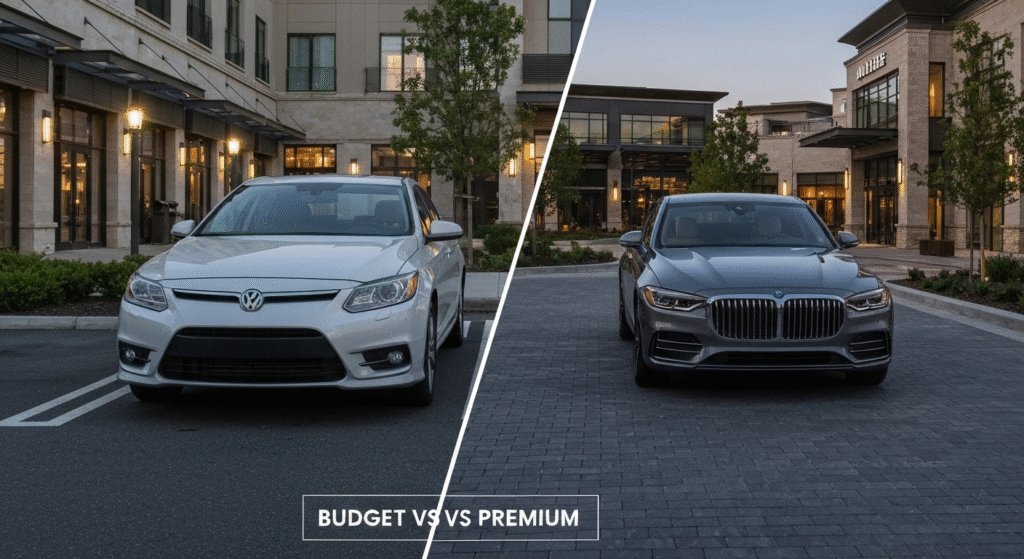
Understanding the true cost of ambient lighting installations helps evaluate different options and make informed purchasing decisions. Total costs include initial kit purchase, installation supplies, potential professional installation fees, and long-term maintenance considerations.
Initial Investment Breakdown Budget installations typically cost $100-$200 including basic kits and installation supplies. Mid-range systems run $200-$500 with more sophisticated components and features. Premium installations can exceed $1000 when including professional installation and high-end components.
DIY vs Professional Installation Costs Professional installation adds $200-$600 to total project costs but provides expertise, warranty coverage, and time savings. DIY installation requires tool investment and time commitment but allows complete control over the process and potential cost savings.
Long-Term Value Considerations Quality ambient lighting systems last 5-10 years with proper installation and maintenance. The initial investment provides years of enhanced interior atmosphere and potential vehicle resale value improvement. Premium systems may qualify as vehicle accessories that maintain some resale value.
Cost FactorDIY InstallationProfessional InstallationKit Cost$50-$500$50-$500Labor$0 (your time)$200-$600Tools$50-$100$0WarrantyLimitedFull coverageTime Investment4-8 hours0 hours
Safety Considerations and Legal Aspects
Ambient lighting installations must consider both safety and legal requirements. Proper installation techniques prevent fire hazards and electrical problems, while compliance with local regulations avoids legal issues.
Electrical Safety Requirements Automotive electrical systems operate at 12 volts, which presents minimal shock hazards but can cause fires if improperly installed. Always use appropriate fusing, secure all connections properly, and avoid overloading electrical circuits. Quality installations include circuit protection and proper wire gauge selection.
Fire Prevention Measures LED lighting generates less heat than traditional bulbs but still requires proper installation to prevent fire hazards. Avoid installing LED strips near flammable materials, ensure adequate ventilation, and use components rated for automotive applications. Never bypass safety features or use inappropriate wire types.
Legal and Regulation Compliance Some jurisdictions regulate aftermarket vehicle lighting to prevent driver distraction or confusion with emergency vehicles. Research local regulations before installation, particularly regarding light colors, brightness levels, and visibility from outside the vehicle. Most interior ambient lighting installations comply with regulations if properly executed.
Frequently Asked Questions
Do ambient lighting kits drain the car battery? Modern LED ambient lighting systems draw minimal power, typically 10-50 watts total. When properly connected to accessory circuits, they turn off with the ignition and won’t drain the battery during parking. Always-on installations may require monitoring to prevent battery depletion.
Can I install ambient lighting without voiding my warranty? Most ambient lighting installations don’t void vehicle warranties if performed properly without damaging existing components. However, any problems caused by improper installation aren’t covered under warranty. Professional installation provides additional protection against warranty concerns.
How long do LED ambient lighting systems last? Quality LED systems typically last 5-10 years or more with proper installation and maintenance. LED degradation occurs gradually over time rather than sudden failure. Most systems maintain adequate brightness and color accuracy throughout their useful life.
Will ambient lighting interfere with my car’s electronics? Properly installed systems with quality components rarely cause interference issues. However, poor installation or low-quality components may affect radio reception or other electronics. Using components designed for automotive applications and following proper installation procedures prevents most interference problems.
Final Thoughts
Ambient lighting kits offer an accessible way to transform your vehicle’s interior atmosphere without major modifications or expense. The technology has matured to the point where reliable, feature-rich systems are available at reasonable prices for most car owners.
Success with these installations depends on careful planning, quality component selection, and attention to installation details. Whether you choose professional installation or tackle the project yourself, the results can dramatically improve your daily driving experience and vehicle enjoyment.
The investment in ambient lighting often pays dividends beyond simple aesthetics. The improved interior atmosphere, reduced eye strain, and enhanced comfort contribute to a more pleasant driving experience that justifies the initial cost and effort required for installation.

